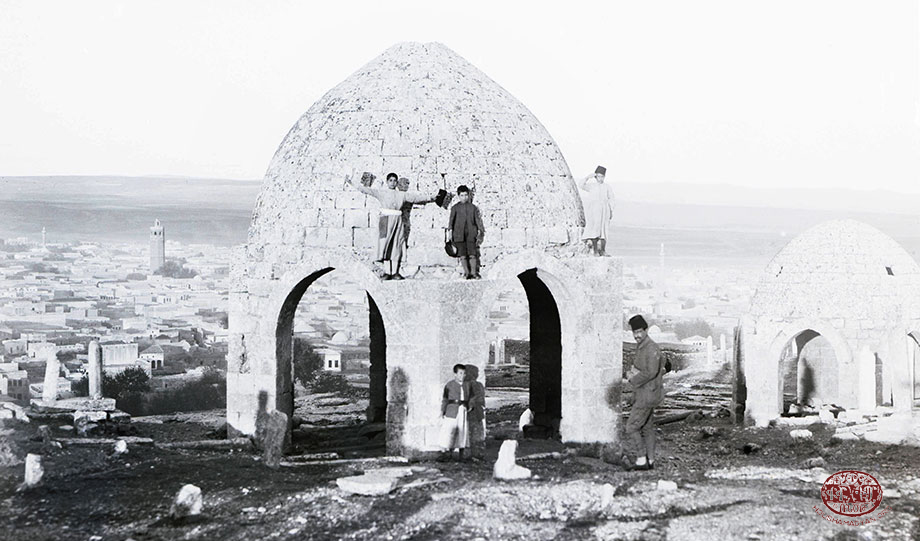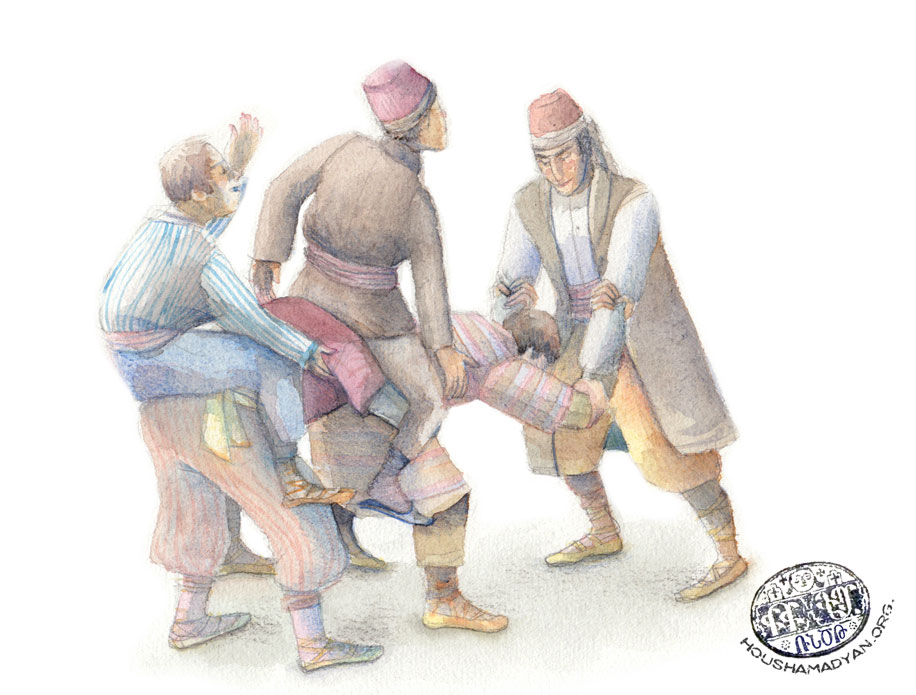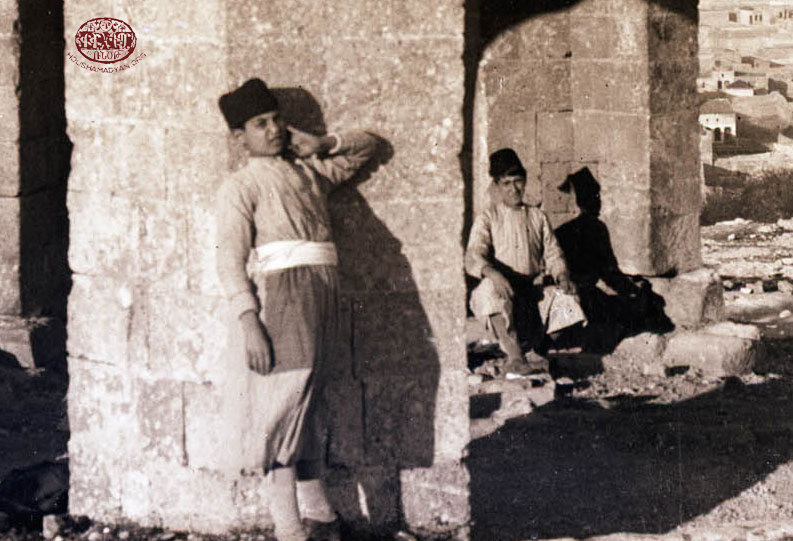Ourfa - Games
Author: Vahé Tachjian, 31/08/16 (Last modified 31/08/16) - Translator: Simon Beugekian
Chekijum
Chekijum was one of the most popular games of Urfa. It was a rather rough, physical game, played mostly by men.
One of the players bends over, holding his shins with his hands. This player is the ‘lounger.’ The other players, one by one, leap over the lounger. Each of them, while in the air, slaps the back of the lounger with an open hand (called a shaplama). Then, once all the players have leapt over, the same players jump onto the lounger’s back. The first jumper attempts to remain on the lounger’s back for a predetermined period of time, without his feet touching the ground and without falling. If he fails, he then becomes the lounger. If he succeeds, the next player jumps onto the lounger’s back, and the same process is repeated. If a lounger, at any point, falls, he is considered to have lost the game.
Darab, Darab
Two teams of competitors are formed. Each team may include up to 20 individuals. The teams line up in rows, facing off, at a distance of 20 meters from each other. The area thus occupied by each team is that team’s ‘base.’ The space between the two bases is the field of play, and no more than one player may enter it. One member of each team is chosen, and these two meet in the field of play for their ‘duel.’ The goal of each player is to wrestle his opponent to his own base. If one of the players is about to pull the other into his base, his teammates may help him by entering the field of play. A player that is pulled entirely into the opposing team’s base is considered to have lost.
One of the more curious stipulations of the game was that while in the field of play, the two opponents could not draw breath (the surviving rules of the game do not indicate how this rule was enforced). If a player drags another near his base and receives the aid of his teammates, these teammates must also hold their breath when they enter the field of play. Throughout the game, the players chant Darab, Darab (meaning unknown).
During the game, it was also customary for the opponents to taunt each other in their unique Urfa dialect. So, one may call out Jenjghoug, jenjghoug, merit babit sekejoug! (“you sparrow! As small as your mother and father!”) Another popular taunt was Hey delije, delije, merit babit ge jenche! (“you falcon! Your mother and father are calling!”) Again, the players had to hold their breath while launching these verbal jibes at each other.
Ergen Esh (Tall Donkey)
Two teams are formed, each with about ten players. Each team’s captain stands with his back against a wall. His teammates then line up in a row facing him, bending over as much as possible and turning their heads toward the captain. The row they make should be a straight line, about two meters long, and should resemble a bridge.
Then, the players on the opposing team leap onto this human bridge. They must remain stationary wherever they fall, and the first ones to leap must make an effort to land as close as possible to the captain, so that they leave enough room for their teammates. It is forbidden for them to move once they land on their opponents’ backs.
The players forming the human bridge must bear the weight. They lose if any of them collapse, thus resulting in the collapse of the entire bridge. As for the jumpers, their team loses if any of them touch the ground after making their leap.
Eshek Beklemen
This was a team game. The ‘lounger’ stands in the middle of a field, bending over and holding his shins. One of his teammates is the designated ‘guardian’ and hovers around the lounger. All other players are on a second team. The objective of the players on the second team is to jump onto the back of the lounger, who is understandably in a vulnerable position. However, his guardian has the responsibility of defending him, and may push back or strike any opponents who approach.
If any of the players of the second team succeed in jumping onto the lounger’s back, he must then escape. He must dismount, and escape the guard, which is not generally easy, as the guard is standing very near. He must find a clever way to make his getaway. His teammates may help by keeping the guard busy. If this player is caught by the guard after dismounting, and cannot escape, he is considered to have lost, and he then assumes the role of the lounger.
Kele Bishdi
A stick is planted in a field, and a rope, about four meters in length, is tied to it. The players take off their shoes, and place them around the stick, within the radius of the rope. Lots are drawn, and one player is designated as the ‘keeper.’ Then the game begins. The keeper must always hold the rope in one hand, and must prevent the other players from grabbing any of the shoes around the stick. If the keeper succeeds in delivering a kick to any of the players attempting to grab shoes, that player then assumes the role of the keeper. If, on the other hand, all of the shoes are captured, the players may attack the keeper and give him a drubbing with the shoes. The only way for the keeper to rescue himself from this gauntlet is to deliver a kick to someone.
Giro Taghvetsek
This team game was played during trips to the fields. Two teams are formed, each with its captain. One team hides, and the other team’s objective is to find the first team. When the signal is given, players on the first team find a good hiding place, and players on the second team, after waiting for a predetermined amount of time, line up behind their captain and march on their opponents, seeking to find them. The captain repeats the call of Giro Taghvetsek! while the team is on its mission. When a player from the first team is found, he must then carry the opponent who found him on his back all the way to a predetermined spot. The game ends when all the players on the first team are found.
Chelig Ped
A popular team game, both in Urfa and elsewhere, usually played during trips to the fields. The players needed cheligs – wooden twigs about 25 cm. in length, with both ends sharpened – to play, as well as jibods, which were longer and thicker. Lots are drawn, and one team must launch its cheligs towards the other team.
The sources are not clear on how the cheligs were launched. We know the jibods were used to strike the cheligs in mid-air, thus propelling them towards the opposite team. But we do not know how the chelig was placed before it was struck. We know that in other locales, the chelig was held in the gap between two rocks, or was placed diagonally leaning against a wall.
The other team stands at a distance of 100 meters. Once the cheligs are launched, they must do their utmost to catch them one by one. If they succeed in catching them, the two teams then switch roles.
Top Degenegi
Top Degenegi was similar to the American game of baseball. To play, one needed a thick bat and a ball, which was usually made using bits of rag tied together with colorful string. Two teams are formed, and they stand at a distance from each other. Like in baseball, one team pitches, and the other bats. The batter has to hit the ball back in the direction of the pitching team, whose members must then try to catch the ball before it hits the ground.
Mismilije
This game was usually played by girls. One player bends over, and the others leapfrog over her. However, while playing the game, the girls also had to recite the following rhyme (a mixture of Armenian, Kurdish, and Turkish):
Mismilij e mismilij
Mismilij e bavete,
Bavete telhavari,
Telhavari Khezmeti,
Khezmeti bash ustene
Bashem duvar ustene,
Chenger changer charkhana,
Gadoun gabets barkhana (the cat tied a barkhana)
Barkhanaya gobia,
Gobia gob gobia,
Altuni Chakhchakhia.
Katsing kenjule mdank (we went into the kenjul)
Yezi pghog me kdank (we found a bull’s pghog)
Kejdetsink kulpe gedrav, (we annoyed him, so……)
Kulpe kulpin antsutsink, (?)
Aha yes yergouks antsutsi (and I myself tied? two of them)
Aha ye yesig dedere deren karetsi (I threw myself from roof to roof)
Other games
The names of some other games played in Urfa have survived, but not much more is known about them. They include tolokha, khorozig, apemud, rastkesme. In the narrow streets of Urfa, boys also often played with marbles (which were known as gulle), though we don’t know what were the rules that governed the marble games.
Source
Aram Sahagian, Mythical Urfa and Her Offspring, published by the Union of Urfa Armenians, Beirut, 1955. Pages 616-621.








